Just Had Drain Cleared Blocked Again
A clogged drain is one problem every homeowner will face sooner or later. The key is knowing the fastest and easiest way to clear that stubborn clogged drain. You're in luck! We've had plenty of experience dealing with slow draining or clogged drains. Even the stubborn ones with the sink clogged past the trap.
You might be interested to know that most drain clogs in the home are caused by just a couple of main culprits. And they normally occur in just a few places. In this article, we will look at those common drain clog causes, their typical locations, and how to clear those clogs.
We will also look at a stubborn drain clog we encountered and what it took to clear it. We're confident there's a solution here to get your water draining freely on most common clogged drain issues. Let's get started.
To be clear, a typical clogged drain will only affect a single drain, whether it's a kitchen or bathroom sink or a bathtub drain. If you have multiple drains, located in different parts of the house, draining slowly you may have a much bigger issue. You may want to consult a plumber to help rule out septic or other sewer system issues outside the home. This article is specifically for individual clogged drains inside the home.
What Are The Different Types Of Drain Clogs?
In my experience, there are two main types of clogs that the average homeowner will experience. They normally form in just a couple of different locations and each of them only requires 15 minutes to locate and clear the clog.
Hair Clogs
If you have anyone with long hair living with you, I am fairly sure you'll eventually face this type of clog. Long hair and drains do not mix very well! Long hair will wrap around anything in its path. Once it gets started, all the other long hair joins the party! Then any other "hair product", soap scum and debris, washed down the drain, begins to add to the problem. As with most clogged drains, you will notice water starting to drain a little slower and it progressively gets worse over time.
Grease And Oil Clogs
The second type of clog typically happens more in the kitchen. It is normally caused by greases and oils going down the drain. And by that, I don't mean pouring large amounts of grease and oil down the drain. Even small amounts of grease and oil going down the drain can cause problems over time.
As the warm grease and oils travel down the drain it cools and tends to stick to the drain pipe. As additional grease goes down the drain it continues to add up and you have the beginning of a clog. Now add other food and debris particles and it slowly becomes even worse.
If you have already ruled out a simple hair or grease clog at the sink and want to get down to business, click the below button below to see how we dealt with stubborn drain issues in this article. You will definitely want to read through the entire step-by-step instructions, in that section, to make sure you get the best results. However, If you are still trying to find the cause and location of your clog, then we highly recommend reading on.
Where Are The Typical Drain Clog Locations?
The location of the clog drains can vary, but there are a couple of different places that are quite common. As a rule, the grease and oil clogs show up in the kitchen and the hair clogs are found in the bathroom drains. Although many of the hair products and conditioners can help add to the problem. I would like to share the areas that have given us the most trouble over the years.
The Drain Plug Lever Assembly Clog
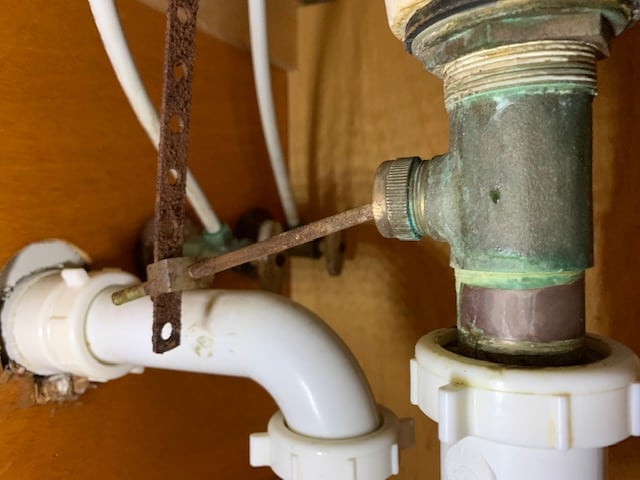
Does your bathroom sink have one of those stoppers with a lever to open and close the drain? If so, that's the first place long hair loves to collect. I routinely remove hair from that drain plug assembly. It's not too difficult to do and you only need a couple of tools to clean clear the clog.
It does require accessing the drain mechanism under the sink. Usually, a small crescent wrench or a pair of pliers is all you need to unclog the drain. This assembly typically is on the backside of the sink drain pipe. The lever shaft used to open and close the drain attaches to it. It's a short shaft held in place by a hex or knurled nut.
How To Remove A Drain Lever Hair Clog
There is a plastic barbed drain clearing tool that can be used with the drain plug in place. The barbed tool snags the hair clog and can pull most of it out. It's good for a short-term fix. However, for stubborn clogs or to completely clear this type of clog you may end up having to pull the plug assembly out at some point.
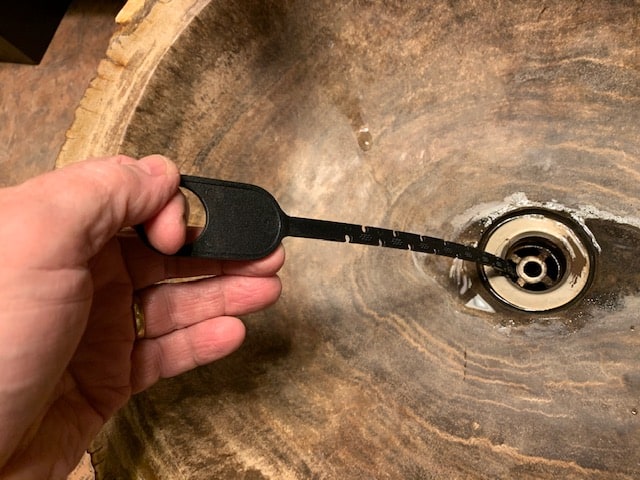
How To Remove The Drain Plug
Using a crescent wrench or pair of pliers, from your "homeowner's toolkit", loosen the hex nut that holds the drain plug in the. Once it has broken loose you should be able to unscrew it by hand. When it comes loose, slide the shaft back about 1/2 inch. You should be able to grab the drain plug in the sink and gently lift it up and out. Be sure to note which way the plug came out of the drain, so it can be reinstalled oriented the same way.
Once the drain plug is lifted out you should be able to look down the drain and see the end of the shaft that the drain plug was connected to. That shaft is one of the most common locations for long hair to gather! With a pair of tweezers or needle-nose pliers, you should be able to reach in there and pull out the hair clogging the drain. If you can't reach it, the plastic barbed drain clearing tool works well here for clearing the hair clog.
Re-install The Drain Plug
Once all the hair is cleaned out re-insert the drain plug with, The proper orientation mentioned above, into the drain and insert the shaft and hex nut underneath into the drain stopper. You may have to try this a couple of times to make sure you get the shaft inserted into the loop on the bottom of the drain plug. Once it's installed correctly, you shouldn't be able to lift the drain plug out of the drain.
Now snug the hex nut on the shaft under the sink. It does not have to be too tight. They typically have a plastic or rubber gasket that is required to seal the shaft and prevent any water leaks. One note, when the hex nut is removed do not run water down the drain. It can, and will, come out of the opening.
The "P" Trap Clog
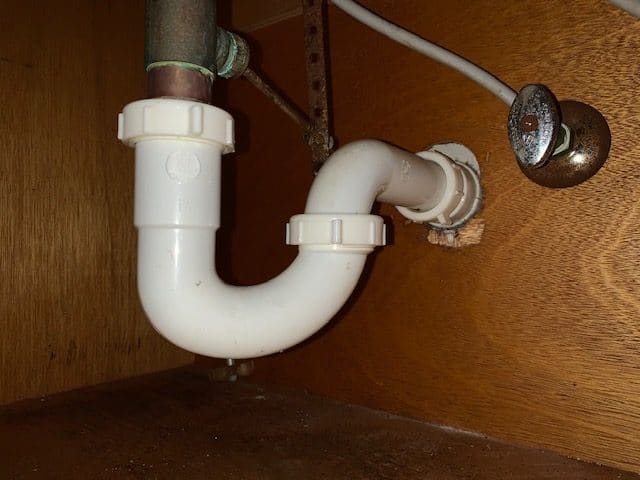
Another common area for a clogged drain is the "P" trap. The "P" trap is the fitting under the sink that has a big dip in it. Contrary to what a lot of people think, that fitting is not there to catch items that get dropped down the drain. The P-trap is actually designed to hold water that basically blocks the drain pipe. That "water plug" blocks sewer gas fumes, in your septic system, from backing up into the house. It has a very important job!
The problem is, even though it wasn't intended to catch items that fall in the sink, that's exactly what it can do. All of our soaps, shampoos, conditioner, and other lotions and creams have the same effect as oil and grease in the kitchen. They coat the piping, including the P-trap area, and are a good place for clogs to form. This is another good place for hair to grab hold of and start forming a clog.
How To Remove A "P" Trap Clog
If you suspect a hair clog, but there is nothing on the drain mechanism, you may have to check the "P" trap for the clog. Hopefully, the plastic hair removal tool will be long enough to reach the clog in the "P" trap. If it cannot reach the clog, then you'll have to remove the "P" trap. Before starting you'll want to place a drip pan under the "P" trap big enough to catch any water in the piping and sink.
On newer PVC drain piping it usually only requires loosening a couple of drain piping nuts and the "P" trap will slide out fairly easily. Most of the time this can be done by hand. PVC drain fittings do not have to be extremely tight. On some older metal pipes, you may need to use a pipe wrench or pliers, but they can be taken apart fairly easily. Once apart you should be able to clear the clog.
In kitchen drains this is where you'll normally start seeing issues with the grease and gunk build up. Do your best to clear as much of the gunk as possible. Once the drain piping is put back together pour a gallon or two of near-boiling water slowly down the drain. This helps to loosen and wash away the debris. If this doesn't take care of the clog, then we move on to the next location.
If you have any concerns about taking the drain piping apart, there are some good resources available to help. One such resource is Black and Decker's "The Complete Guide To Plumbing". This book is available at Amazon and it makes a great addition to a DIY'ers library. There is a Kindle version if you prefer an electronic library.
How To Clear Stubborn Drain Clogs
Normally the first two locations have always been the source of our problems. That is until recently! We had a clog develop inside the kitchen sink drain pipe somewhere beyond the P-trap. I tried the plunger, chemical drain cleaners and a few other alternative methods, like baking soda and vinegar and Dawn dish soap and hot water, but none of them worked.
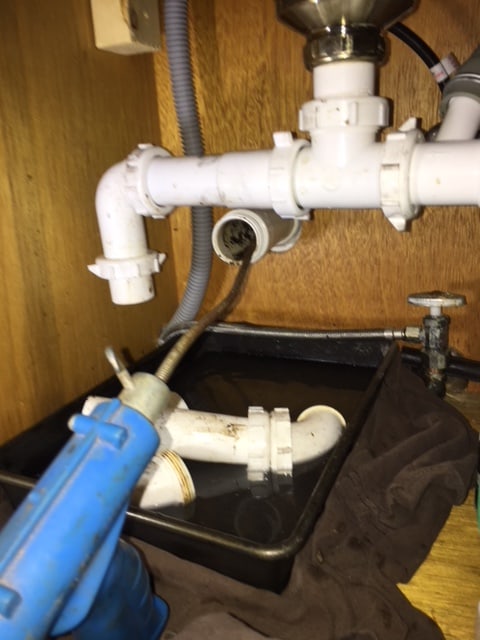
Next, I tried a plumbers snake. I had to remove the "P" trap to use it. I was able to feed the snake into the wall piping was about 15 feet. When I pulled it out it was coated with the greasy, organic gunk described above.
I put the drain pipe back together and poured boiling water down the drain, but the drain still didn't flow. In fairness to the plumber's snake, I think it would work fine on a hair clog if you could reach it.
At this point, I had tried everything I could think of but with no luck. So now it's time to break out my new favorite drain clog busting tool.
How To Clear A Sink Clogged Past The Trap With A Shop Vac
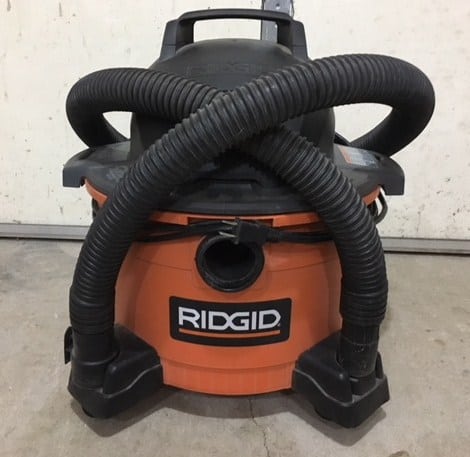
Our recent stubborn kitchen drain clog started out as a slow drain issue, but eventually completely clogged. As mentioned above, I tried everything I could think of, but nothing worked! Then I found the easiest and fastest method to clear a stubborn clogged drain. It was my wet/dry shop vacuum! Not only is it easy and fast, but there is far less mess involved.
Before starting you can use it to suck up any standing water out of the sink. It will even pull most of the water out of the "P" trap right from the sink. On a stubborn clog like ours, you'll need to remove the "P" trap to access the drain piping. I still recommend using a drip pan because you may not get all the water out of the sink and piping with the vacuum.
With the "P" trap removed, place the end of the shop vac hose over the drain pipe and turn the vacuum on. After hours of trying all kinds of solutions, the shop vac cleared our stubborn clog in less than a minute.
Depending on exactly where the clog is there may be an extra step or two in clearing your clog. Below is a little information on a typical home's drain system and how the shop vacuum method works. You will also find the possible clog locations you may encounter and the steps you'll need to follow to remove them.
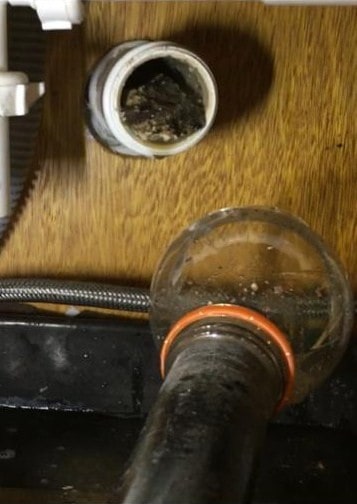
Understand Your Home Drain System For Best Results
For the best results when using a wet/dry vacuum on different clog locations, it's best to know how a typical home drain system is laid out and works.
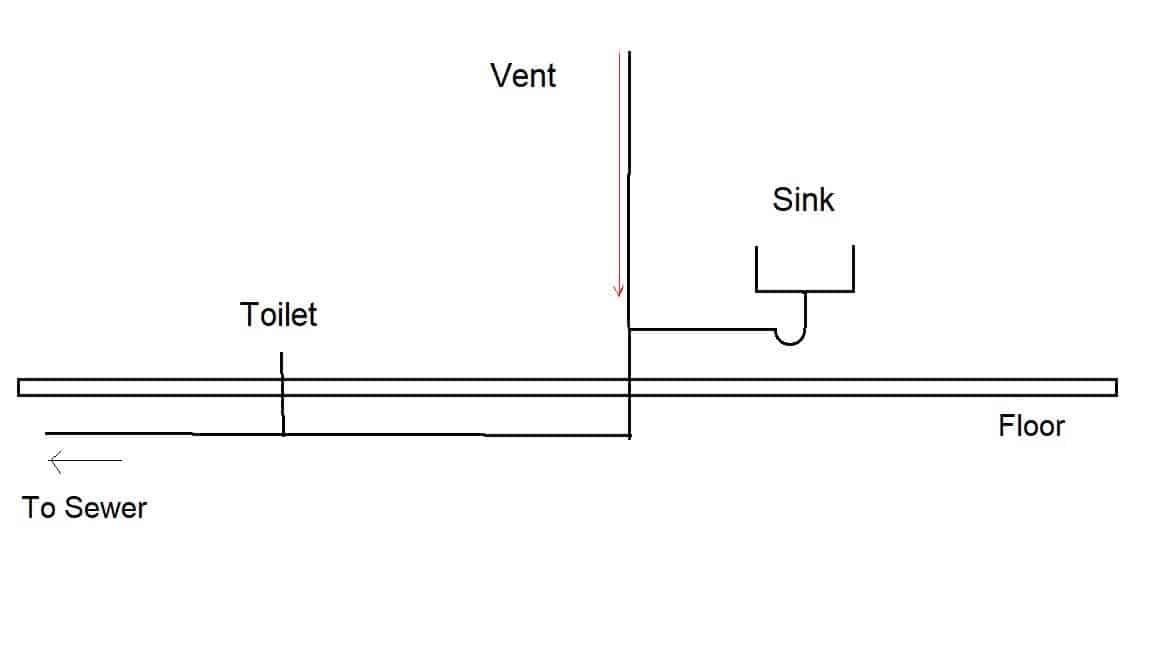
Here is a simple diagram of a home drain system. Your home's drain system relies on gravity to do its job. However, when water flows down a pipe it creates a suction behind it, so it will continue to flow until all the water is gone. Just like siphoning gas from a gas tank.
Remember the function of the "P" trap I mentioned earlier? The water in the "P" trap forms a plug that keeps sewer gas from coming back into the house. So gravity and the vent line work together. Gravity allows the water to drain and the vent prevents the suction from the draining water from pulling the water from the "P" trap.
How To Remove A Drain Clog Before The Vent Pipe
If your clog is in the piping prior to the vent, again it's pretty straightforward. Much of it relies on what type of drain plug or grate you have. On stubborn clogs, it would probably be best to remove the "P" trap and pull directly on the drain piping with the vacuum. By doing this there will be less airflow restriction, which will provide stronger suction on the clog.
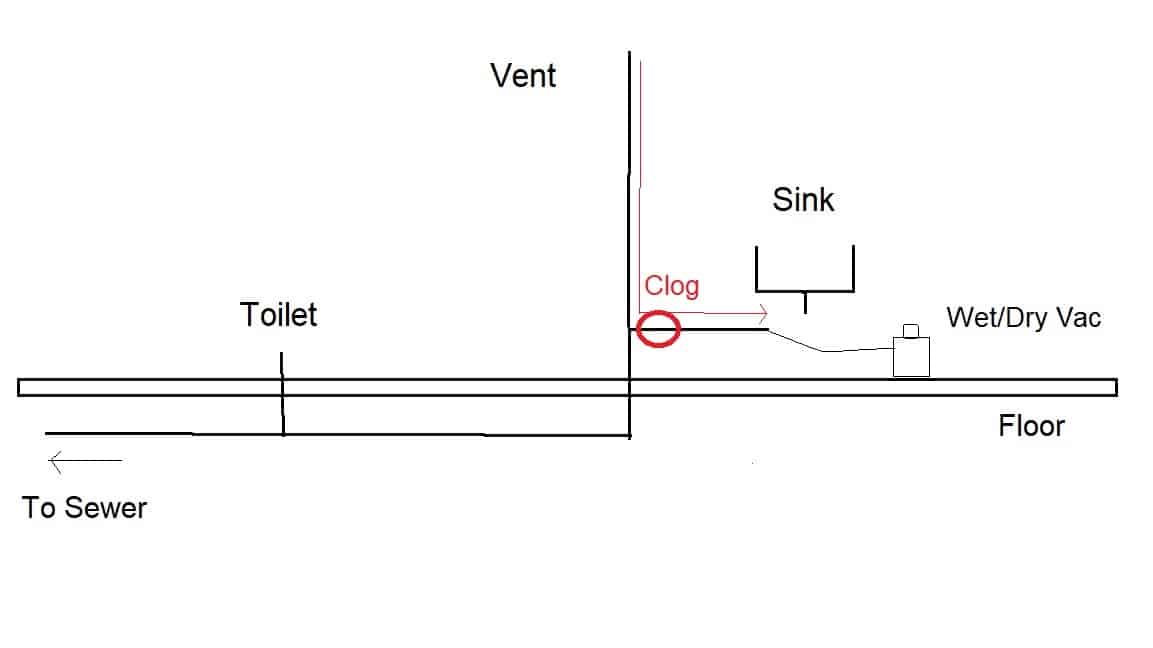
How To Remove A Drain Clog After The Vent Pipe
Although very similar to the clog before the vent line, this clog location will add another step to the process. Looking at the diagram you'll see why. When you start the vacuum the principle of "path of least resistance" will definitely apply. It will simply pull air from the vent and leave the clog untouched.
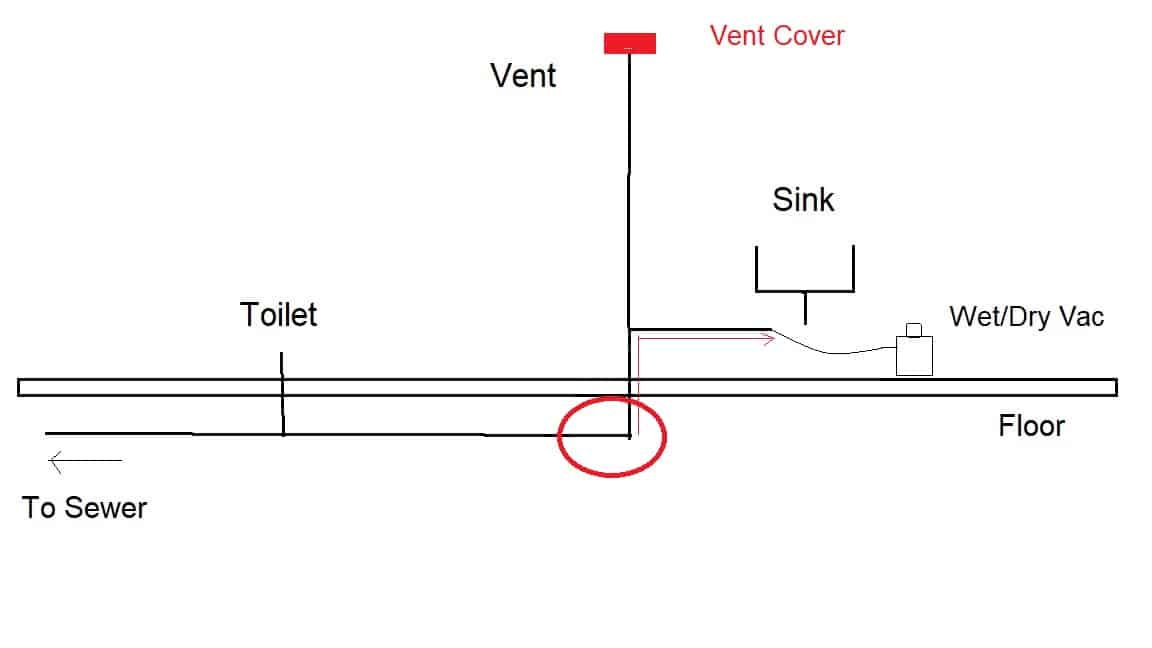
If your clog is not in the "P" trap or sink, this is actually the best way to determine where your clog is located. Hook the vacuum up to the drain piping and turn it on. If the clog comes out, the problem solved! If it doesn't come out, then move on to the next step.
The next step involves blocking the vent line. This ensures the vacuum is pulling only on the drain line. Anything that will seal the vent will work fine. It doesn't have to be a high-tech device like I used in the photo below. 🙂 Keep in mind some homes have more than one septic/sewer vent line. If your home does, plug both and try again.
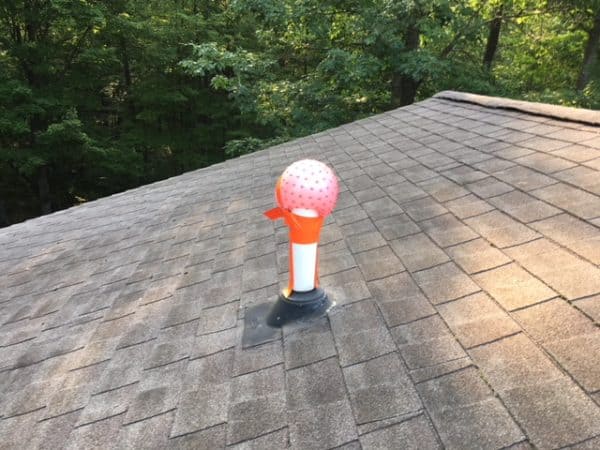
Tips For Clearing A Sink Clogged After The P-Trap With A Shop Vacuum
For most clogs in the sink and "P" trap area, it's pretty straightforward. However, there are a few things you need to know before attempting to clear a drain clog using a vacuum.
How To Prevent Clogged Drains
As I said at the beginning of this article, I believe all homeowners will experience a slow or clogged drain at some point. The good news is there are things you can do to help prevent clogs or at least reduce the frequency between clogs. To help keep your drains flowing free and clear, use some of the below ideas.
Final Thoughts
Clogged drains are one of the most frustrating things a homeowner has to deal with. However, now if you have a problem with a sink draining slowly, I honestly think that one of the above methods of locating and clearing the clog will work in 95% of the cases.
We all know that shop vacs are great for cleaning up dirt and liquid spills, but now you know how effective they are at making short work of clogged drains! If you don't already have a wet/dry shop vacuum, I highly recommend investing in one today.
If you have any comments or questions, you can leave them in the comments section below or you can email us at [email protected] FYI, we do not collect or share email addresses. We will only use them to reply to your comments or provide answers to your questions. We are also required to let you know that some of our links are "affiliate links". This means if you click on a link and make a purchase, we could make a small commission, at no extra cost to you. This helps offset the cost of maintaining our website. So, if you like what you've seen, please be sure to give us a "Like" and "Share" on Facebook and Instagram too. Thank you for reading and good luck with all your home projects!
Source: https://www.ourrecipesforsuccess.com/clear-a-clogged-drain/
Post a Comment for "Just Had Drain Cleared Blocked Again"